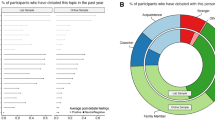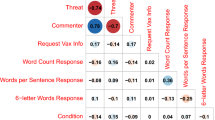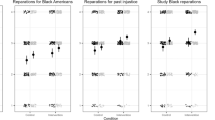Abstract
Receiving help can make or break a career, but women and racial/ethnic minorities do not always receive the support they seek. Across two audit experiments—one with politicians and another with students—as well as an online experiment (total n = 5,145), we test whether women and racial/ethnic minorities benefit from explicitly mentioning their demographic identity in requests for help, for example, by including statements like “As a Black woman…” in their communications. We propose that when a help seeker highlights their marginalized identity, it may activate prospective helpers’ motivations to avoid prejudiced reactions and increase their willingness to provide support. Here we show that when women and racial/ethnic minorities explicitly mentioned their demographic identity in help-seeking emails, politicians and students responded 24.4% (7.42 percentage points) and 79.6% (2.73 percentage points) more often, respectively. These findings suggest that deliberately mentioning identity in requests for help can improve outcomes for women and racial/ethnic minorities.
This is a preview of subscription content, access via your institution
Access options
Access Nature and 54 other Nature Portfolio journals
Get Nature+, our best-value online-access subscription
$29.99 / 30 days
cancel any time
Subscribe to this journal
Receive 12 digital issues and online access to articles
$119.00 per year
only $9.92 per issue
Buy this article
- Purchase on Springer Link
- Instant access to full article PDF
Prices may be subject to local taxes which are calculated during checkout



Similar content being viewed by others
Data availability
De-identified participant data from Studies 1, 2 and 3 are permanently and publicly available in an OSF folder at https://doi.org/10.17605/OSF.IO/5DHBE. There are no restrictions on data availability. These data include information about participant responses, condition assignment and any preregistered control variables for each of our studies. The OSF folder also includes preregistrations for Studies 1, 2 and 3 as well as a copy of our Supplementary Information, which contains further details about our experimental methods and results (for example, stimulus language, screenshots of surveys shared with participants in Study 3 and results of robustness checks). Figures that have associated raw data include Figs. 1, 2 and 3. The raw data for these figures are also included in the OSF folder. Source data are provided with this paper.
Code availability
The code to replicate the analyses in the manuscript and our Supplementary Information is available permanently and publicly in an OSF folder at https://doi.org/10.17605/OSF.IO/5DHBE.
References
Coury, S. et al. Women in the workplace 2020. McKinsey & Company https://www.mckinsey.com/featured-insights/diversity-and-inclusion/women-in-the-workplace (2020).
The NCES Fast Facts Tool provides quick answers to many education questions. National Center for Education Statistics https://nces.ed.gov/fastfacts/display.asp?id=61 (2020).
Butler, D. M. & Broockman, D. E. Do politicians racially discriminate against constituents? A field experiment on state legislators. Am. J. Pol. Sci. 55, 463–477 (2011).
Giuliano, L., Levine, D. I. & Leonard, J. Racial bias in the manager-employee relationship an analysis of quits, dismissals, and promotions at a large retail firm. J. Hum. Resour. 46, 26–52 (2011).
Keeves, G. D. & Westphal, J. D. From help to harm: increases in status, perceived underreciprocation, and the consequences for access to strategic help and social undermining among female, racial minority, and white male top managers. Organization Sci. 32, 909–1148 (2021).
Lavy, V. & Sand, E. On the origins of gender gaps in human capital: short-and long-term consequences of teachers’ biases. J. Public. Econ. 167, 263–279 (2018).
McDonald, M. L., Keeves, G. D. & Westphal, J. D. One step forward, one step back: White male top manager organizational identification and helping behavior toward other executives following the appointment of a female or racial minority CEO. Acad. Manag. J. 61, 405–439 (2018).
Milkman, K. L., Akinola, M. & Chugh, D. Temporal distance and discrimination: an audit study in academia. Psychol. Sci. 23, 710–717 (2012).
Milkman, K. L., Akinola, M. & Chugh, D. What happens before? A field experiment exploring how pay and representation differentially shape bias on the pathway into organizations. J. Appl. Psychol. 100, 1678–1712 (2015).
Price, J. & Wolfers, J. Racial discrimination among NBA referees. Q. J. Econ. 125, 1859–1887 (2010).
White, A. R., Nathan, N. L. & Faller, J. K. What do I need to vote? Bureaucratic discretion and discrimination by local election officials. Am. Polit. Sci. Rev. 109, 129–142 (2015).
Kalla, J., Rosenbluth, F. & Teele, D. L. Are you my mentor? A field experiment on gender, ethnicity, and political self-starters. J. Politics 80, 337–341 (2018).
Eby, L. T., Allen, T. D., Evans, S. C., Ng, T. & DuBois, D. L. Does mentoring matter? A multidisciplinary meta-analysis comparing mentored and non-mentored individuals. J. Vocat. Behav. 72, 254–267 (2008).
Kaas, L. & Manger, C. Ethnic discrimination in Germany’s labour market: a field experiment. Ger. Econ. Rev. 13, 1–20 (2012).
Seibert, S. E., Kraimer, M. L. & Liden, R. C. A social capital theory of career success. Acad. Manag. J. 44, 219–237 (2001).
Bohren, J. A., Imas, A. & Rosenberg, M. The dynamics of discrimination: theory and evidence. Am. Econ. Rev. 109, 3395–3436 (2019).
Doleac, J. L. & Stein, L. C. The visible hand: race and online market outcomes. Econ. J. 123, F469–F492 (2013).
Edelman, B., Luca, M. & Svirsky, D. Racial discrimination in the sharing economy: evidence from a field experiment. Am. Econ. J. Appl. Econ. 9, 1–22 (2017).
Kang, S. K., DeCelles, K. A., Tilcsik, A. & Jun, S. Whitened résumés: race and self-presentation in the labor market. Adm. Sci. Q. 61, 469–502 (2016).
Bertrand, M. & Mullainathan, S. Are Emily and Greg more employable than Lakisha and Jamal? A field experiment on labor market discrimination. Am. Econ. Rev. 94, 991–1013 (2004).
Dovidio, J. F. & Gaertner, S. L. Aversive racism and selection decisions: 1989 and 1999. Psychol. Sci. 11, 315–319 (2000).
Plant, E. A. & Devine, P. G. Internal and external motivation to respond without prejudice. J. Pers. Soc. Psychol. 75, 811–832 (1998).
Apfelbaum, E. P., Sommers, S. R. & Norton, M. I. Seeing race and seeming racist? Evaluating strategic colorblindness in social interaction. J. Pers. Soc. Psychol. 95, 918 (2008).
Bodner, R. & Prelec, D. in The Psychology of Economic Decisions Vol. 1 (eds Brocas, I. & Carillo, J.) (Oxford Univ. Press, 2003).
Paluck, E. L. & Green, D. P. Prejudice reduction: what works? A review and assessment of research and practice. Annu. Rev. Psychol. 60, 339–367 (2009).
Plant, E. A. & Devine, P. G. The active control of prejudice: unpacking the intentions guiding control efforts. J. Pers. Soc. Psychol. 96, 640–652 (2009).
Rokeach, M. Long-range experimental modification of values, attitudes, and behavior. Am. Psychol. 26, 453–459 (1971).
Pope, D. G., Price, J. & Wolfers, J. Awareness reduces racial bias. Manag. Sci. 64, 4988–4995 (2018).
Sommers, S. R. & Ellsworth, P. C. White juror bias: an investigation of prejudice against Black defendants in the American courtroom. Psychol. Public. Policy. Law. 7, 201–229 (2001).
Banaji, M. R. & Hardin, C. D. Automatic stereotyping. Psychol. Sci. 7, 136–141 (1996).
Devine, P. G. Stereotypes and prejudice: their automatic and controlled components. J. Pers. Soc. Psychol. 56, 5–18 (1989).
Taylor, S. E., Fiske, S. T., Etcoff, N. L. & Ruderman, A. J. Categorical and contextual bases of person memory and stereotyping. J. Pers. Soc. Psychol. 36, 778–793 (1978).
Ai, C. & Norton, E. C. Interaction terms in logit and probit models. Econ. Lett. 80, 123–129 (2003).
Gomila, R. Logistic or linear? Estimating causal effects of experimental treatments on binary outcomes using regression analysis. J. Exp. Psychol. Gen. 150, 700–709 (2021).
Butler, D. M. & Crabtree, C. Moving beyond measurement: adapting audit studies to test bias-reducing interventions. J. Exp. Pol. Sci. 4, 57 (2017).
Einstein, K. L. & Glick, D. M. Does race affect access to government services? An experiment exploring street-level bureaucrats and access to public housing. Am. J. Pol. Sci. 61, 100–116 (2017).
Barron, G. & Yechiam, E. Private e-mail requests and the diffusion of responsibility. Comput. Hum. Behav. 18, 507–520 (2002).
Bullock, J. G., Green, D. P. & Ha, S. E. Yes, but what’s the mechanism? (Don’t expect an easy answer). J. Pers. Soc. Psychol. 98, 550–558 (2010).
Imai, K., Keele, L. & Tingley, D. A general approach to causal mediation analysis. Psychol. Methods. 15, 309–334 (2010).
Imai, K., Keele, L. & Yamamoto, T. Identification, inference and sensitivity analysis for causal mediation effects. Stat. Sci. 25, 51–71 (2010).
Fishbane, A., Ouss, A. & Shah, A. K. Behavioral nudges reduce failure to appear for court. Science 370, eabb6591 (2020).
Tiefenbeck, V. et al. Overcoming salience bias: How real-time feedback fosters resource conservation. Manag. Sci. 64, 1458–1476 (2018).
Zhang, T., Fletcher, P. O., Gino, F. & Bazerman, M. H. Reducing bounded ethicality: how to help individuals notice and avoid unethical behavior. Organ. Dyn. 44, 310–317 (2015).
Butz, D. A. & Plant, E. A. Prejudice control and interracial relations: the role of motivation to respond without prejudice. J. Pers. 77, 1311–1342 (2009).
Glover, D., Pallais, A. & Pariente, W. Discrimination as a self-fulfilling prophecy: evidence from French grocery stores. Q. J. Econ. 132, 1219–1260 (2017).
Heilman, M. E. Description and prescription: how gender stereotypes prevent women’s ascent up the organizational ladder. J. Soc. Issues. 57, 657–674 (2001).
Ibarra, H. Homophily and differential returns: sex differences in network structure and access in an advertising firm. Adm. Sci. Q. 37, 422–447 (1992).
Rosette, A. S., Leonardelli, G. J. & Phillips, K. W. The White standard: racial bias in leader categorization. J. Appl. Psychol. 93, 758–777 (2008).
Watkins, M. B., Simmons, A. & Umphress, E. It’s not black and white: toward a contingency perspective on the consequences of being a token. Acad. Manag. Perspect. 33, 334–365 (2019).
City and town population totals: 2010–2019. U.S. Census Bureau https://www.census.gov/data/datasets/time-series/demo/popest/2010s-total-cities-and-towns.html (2020).
Kirgios, E. L., Rai, A., Chang, E. H. & Milkman, K. L. When seeking help, women and racial/ethnic minorities benefit from explicitly stating their demographic identity. OSF https://doi.org/10.17605/OSF.IO/5DHBE (2021).
Acknowledgements
This material is based upon work supported by the National Science Foundation Graduate Research Fellowship under grant no. DGE-1845298 (awarded to E.L.K.) and the Wharton School. The funders had no role in study design, data collection and analysis, decision to publish or preparation of the manuscript. We are grateful to A. Duckworth, J. Kessler, A. Rees-Jones, I. Silver and attendees at the Society for Judgment and Decision Making conference for their feedback. We also thank K. Shonk and K. Brabaw for providing editorial input on this manuscript and the Wharton Behavioural Lab for their assistance in gathering data for this research. Finally, we are grateful to the many research assistants who helped us make this work possible, particularly K. Herrera, M. Chung, M. Huang, C. Kornicker and G.M. Waldman.
Author information
Authors and Affiliations
Contributions
E.L.K., A.R., E.H.C. and K.L.M. designed and performed the research. E.L.K. and A.R. analysed the data. E.L.K. wrote the paper. A.R., E.H.C. and K.L.M. provided critical feedback on the paper. E.L.K. prepared the supplementary materials.
Corresponding author
Ethics declarations
Competing interests
The authors declare no competing interests.
Peer review
Peer review information
Nature Human Behaviour thanks the anonymous reviewers for their contribution to the peer review of this work.
Additional information
Publisher’s note Springer Nature remains neutral with regard to jurisdictional claims in published maps and institutional affiliations.
Supplementary information
Supplementary Information
Additional details for Supplementary Methods for Studies 1–3, Tables 1–24 and Fig. 1, and screenshots from surveys used in Studies 2 and 3.
Source data
Source Data Fig. 1
Statistical source data.
Source Data Fig. 2
Statistical source data.
Source Data Fig. 3
Statistical source data.
Rights and permissions
About this article
Cite this article
Kirgios, E.L., Rai, A., Chang, E.H. et al. When seeking help, women and racial/ethnic minorities benefit from explicitly stating their identity. Nat Hum Behav 6, 383–391 (2022). https://doi.org/10.1038/s41562-021-01253-y
Received:
Accepted:
Published:
Issue Date:
DOI: https://doi.org/10.1038/s41562-021-01253-y
This article is cited by
-
Validated names for experimental studies on race and ethnicity
Scientific Data (2023)



